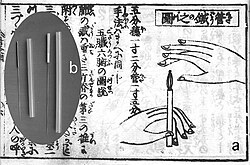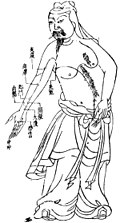Acupuncture
Acupuncture is an ancient kind of medical treatment where the doctor sticks needles in certain places of a person's body. The oldest records are at least 2,500 years old.[1] Thin metal needles are pushed into the body at certain places called "acupuncture points".[2] It is a form of alternative medicine,[3] and a key part of Traditional Chinese medicine (TCM).[4] It uses the Chinese philosophy of yin and yang.[2]
Effectiveness
There is no general agreement as to whether acupuncture is effective. It is difficult to do good research on this issue.[5][6]
A 2014 review article said "researchers usually find that it generally does not matter where the needles are inserted, how often (that is, no dose-response effect is observed), or even if needles are actually inserted. In other words, 'sham' or 'placebo' acupuncture generally produces the same effects as 'real' acupuncture and, in some cases, does better".[7] A 2013 analysis found little evidence that the effectiveness of acupuncture on pain (compared to sham) was modified by the location of the needles, the number of needles used, the experience or technique of the practitioner, or by the circumstances of the sessions.[8]
Using the principles of "evidence-based medicine" (scientific research) to research acupuncture is controversial, and has produced different results.[9] Some research suggests acupuncture can alleviate pain but the majority of research suggests that acupuncture's effects are mainly due to placebo.[10] Evidence suggests that any benefits of acupuncture are short-lasting.[11] There is insufficient evidence to support use of acupuncture compared to mainstream medical treatments.[12] Acupuncture is not better than mainstream treatment in the long term.[13]
A 2023 review stated that "acupuncture may represent an effective complementary treatment approach for PD depression; although, the optimal methods and techniques for this population need further investigation".[14]
Operations using acupuncture
Chinese doctors have claimed to perform surgery with acupuncture as the only anaesthetic.[15] This is a claim which is difficult to test. In some cases at least, the claim has been fraudulent, because morphine, or other sedatives were delivered through a drip.[16][17] In 2006, a BBC documentary Alternative Medicine filmed a patient undergoing open heart surgery allegedly under acupuncture-induced anesthesia. It was later revealed that the patient had been given a cocktail of anesthetics.[18][19][20]
The present
Recently, acupuncture has begun to be used more frequently in the West.[2][15] In the United States acupuncture has often been used to help control pain and drug and alcohol addiction. It is also often used to treat headaches, asthma, and arthritis.[15] It is widely agreed that acupuncture treatment is safe when done by well-trained doctors using clean needles.[21][21] It can be dangerous when performed by untrained or unlicensed practitioners however.[22]
Guidelines from the NICE (National Institute for Health and Care Excellence) is that "The National Institute for Health and Care Excellence (NICE) only recommends considering acupuncture as a treatment option for chronic lower back pain, chronic tension-type headaches and migraine".[23][24]
Acupuncture Media
Acupuncture chart from the Ming dynasty (c. 1368 – c. 1644)
Acupuncture chart from Shisi jing fahui (Expression of the Fourteen Meridians) written by Hua Shou (fl. 1340s, Ming dynasty). Japanese reprint by Suharaya Heisuke (Edo, 1. year Kyōhō = 1716).
An ancient Acupuncture statue at the lobby of the Emperor's College clinic, California
References
- ↑ "The History of Acupuncture and Traditional Chinese Medicine". www.nyacuhealth.com. Archived from the original on 2020-06-25. Retrieved 2020-06-26.
- ↑ 2.0 2.1 2.2 "acupuncture (medicine) -- Britannica Online Encyclopedia". britannica.com. Retrieved 17 June 2010.
- ↑ Berman, Brian et al 2010. Acupuncture for chronic low back pain. New England Journal of Medicine 363 (5): 454–461. [1]
- ↑ Liu, Gang et al 2013. Effects of painful stimulation and acupuncture on attention networks in healthy subjects. Behavioral and Brain Functions 9 (1): 23. Complete article:[2]
- ↑ White A.R. et al (International Acupuncture Research Forum) 2001. Clinical trials of acupuncture: consensus recommendations for optimal treatment, sham controls and blinding. Complementary Therapies in Medicine 9 (4): 237–245. [3]
- ↑ Witt, Claudia et al 2012. Effectiveness guidance document (EGD) for acupuncture research - a consensus document for conducting trials. BMC Complementary and Alternative Medicine 12 (1), 148. [4]
- ↑ Gorski, David H. 2014. Integrative oncology: really the best of both worlds?. Nature Reviews Cancer. [5]
- ↑ MacPherson, Hugh et al (Acupuncture Trialists' Collaboration) 2013. Characteristics of acupuncture treatment associated with outcome: an individual patient meta-analysis of 17,922 patients with chronic pain in randomised controlled trials. PLoS ONE 8 (10): e77438. [6]
- ↑ Ernst, E.; Pittler, MH; Wider, B; Boddy, K (2007). "Acupuncture: its evidence-base is changing". The American Journal of Chinese Medicine. 35 (1): 21–25. doi:10.1142/S0192415X07004588. PMID 17265547.
- ↑ Ernst E. 2006. Acupuncture--a critical analysis. Journal of Internal Medicine 259 (2): 125–137. [7]
- ↑ Wang, Shu-Ming; Kain, Zeev N.; White, Paul F. (2008). "Acupuncture Analgesia: II. Clinical Considerations". Anesthesia & Analgesia. 106 (2): 611–621. doi:10.1213/ane.0b013e318160644d. ISSN 0003-2999. PMID 18227323. S2CID 24912939.
- ↑ Lee Goldman; Andrew I. Schafer (21 April 2015). Goldman-Cecil Medicine: Expert Consult - Online. Elsevier Health Sciences. pp. 98–. ISBN 978-0-323-32285-0.
- ↑ Amezaga Urruela, Matxalen & Suarez-Almazor, Maria E. 2012. Acupuncture in the treatment of rheumatic diseases. Current Rheumatology Reports 14 (6): 589–597. [8]
- ↑ Angelopoulou, Efthalia; Stanitsa, Evangelia; Karpodini, Claire Chrysanthi; Bougea, Anastasia; Kontaxopoulou, Dionysia; Fragkiadaki, Stella; Koros, Christos; Georgakopoulou, Vasiliki Epameinondas; Fotakopoulos, George; Koutedakis, Yiannis; Piperi, Christina (2023-08-12). "Pharmacological and Non-Pharmacological Treatments for Depression in Parkinson's Disease: An Updated Review". Medicina (Kaunas, Lithuania). 59 (8): 1454. doi:10.3390/medicina59081454. ISSN 1648-9144. PMC 10456434. PMID 37629744.
{{cite journal}}: Check|pmc=value (help); Check|pmid=value (help) - ↑ 15.0 15.1 15.2 "Acupuncture". The Kingfisher Children's Encyclopedia. Vol. 1. Kingfisher Books. 1994. p. 6.
- ↑ Keng H.C. & Tao N.H. 1985. The evaluation of acupuncture anesthesia must seek truth from facts. (Translated by P. U. Unschuld). In Medicine in China: a history of ideas. Unschuld P.U. (ed). Berkeley: University of California Press.
- ↑ Colquhoun D. & Novella S. 2013. Acupuncture is a theatrical placebo: the end of a myth. Anesthesia & Analgesia 116 (6): 1360–1363. [9]
- ↑ Simon Singh (26 March 2006). "A groundbreaking experiment ... or a sensationalized TV stunt?". The Guardian. http://www.guardian.co.uk/media/2006/mar/25/science.broadcasting.
- ↑ Simon Singh (14 February 2006). "Did we really witness the 'amazing power' of acupuncture?". Daily Telegraph. https://www.telegraph.co.uk/science/science-news/3344833/Did-we-really-witness-the-amazing-power-of-acupuncture.html. Retrieved 1 April 2018.
- ↑ "Acupuncture resources". www.acuandherbs.com. Archived from the original on 2016-02-01. Retrieved 2015-11-15.
- ↑ 21.0 21.1 "The NIH Consensus Development Program: Acupuncture". consensus.nih.gov. Archived from the original on 25 August 2011. Retrieved 17 June 2010.
- ↑ https://www.hk01.com/article/1070665
- ↑ "Acupuncture - Evidence. NICE 2014". Archived from the original on 2010-08-14. Retrieved 2015-10-06.
- ↑ "Can Acupuncture Help with Lower Back Pain?". Archived from the original on 2021-03-22. Retrieved 2021-03-20.
Further reading
- Fung, Alice (23 Mar 2024). "Traditional Chinese medicine acupuncture wins over French friends". GDToday. Retrieved 12 Mar 2025.
... combined ... acupuncture, cupping, pricking blood, Gua Sha, thread-embedding, and point injection, as well as internal administration of Chinese herbal medicine ...









